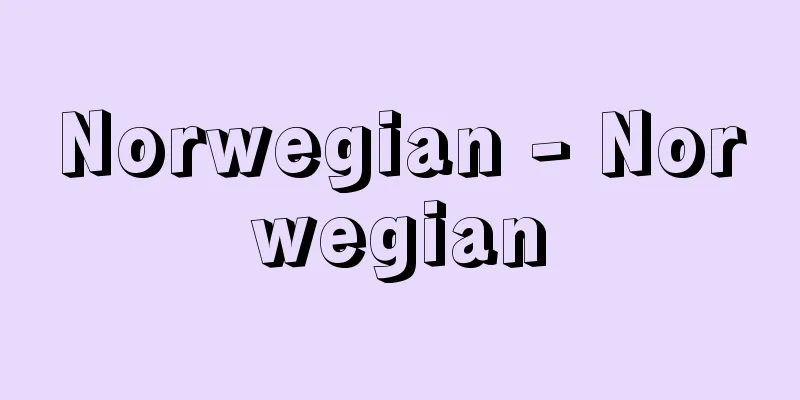Norwegian - Norwegian

|
The official language of the Kingdom of Norway. It belongs to the Germanic Nordic languages of the Indo-European language family and is closely related to the neighboring languages Swedish and Danish. The phonetic system and accent are similar to Swedish: for example, p, t, and k follow vowels, and g, k, and sk are palatalized at the beginning of words. There are also two types of accent: a gentle rising accent (which in Swedish is a falling accent) and a sudden rising accent. The language situation in Norway is more complicated than in Sweden or Denmark, and currently two types of Norwegian are recognized as official languages. Since 1929, the official names have been bokmål and nynorsk. There is a historical background to this. After the Reformation, the Bible was translated in Sweden under Gustav I (Gustav Vasa) and in Denmark under Christian III, and modern written languages were established in each country. In contrast, Norway adopted the Danish written language because it was in a personal union with Denmark, and although the pronunciation was Norwegian, it imitated Danish in vocabulary, grammar, and orthography. This was called riksmål, which later became bokmål. On the other hand, against the backdrop of the rise of national consciousness in the 19th century, Ivar Aasen (1813-96) created landsmål based on ancient Norwegian dialects in an attempt to create a unique Norwegian written language. It was very old-fashioned and purist, using full vowels in weak syllables, returning to the old diphthongs, restoring the feminine to nouns in grammar, and eliminating loanwords and foreign words. Ransmål also gained official language status in 1885. This later became Nynorsk. In the 20th century, the orthography of Bokmål was significantly revised, making it closer to Nynorsk. Bokmål is mainly used in the eastern part of Norway, including Oslo, and Nynorsk in the western part of Norway, but in terms of the number of users, it can be said that Bokmål is overwhelmingly more prevalent. [Nobuko Fukui] "Express Norwegian" by Yokoyama Tamishi (1987, Hakusuisha)" ▽ "Introduction to Norwegian Grammar - Bokmål" by Mori Nobuyoshi (1990, Daigaku Shorin)" ▽ "Self-Study Norwegian Grammar" by Okamoto Takeshi (1993, Daigaku Shorin)" ▽ "Nordic Languages" edited by Alan Kirker et al., translated by Yamashita Yasufumi et al. (2001, Tokai University Press) [References] |Source: Shogakukan Encyclopedia Nipponica About Encyclopedia Nipponica Information | Legend |
|
ノルウェー王国の公用語。インド・ヨーロッパ語族ゲルマン語派ノルド諸言語に属する言語で、隣国のスウェーデン語、デンマーク語とたいへん近い関係にある。 音声体系とアクセントはスウェーデン語に類似している。たとえば、母音の直後にp、t、kが存在し、語頭でg、k、skが口蓋(こうがい)化する。また、なだらかな上昇調のアクセント(スウェーデン語では下降調)と、下降後急に上昇するアクセントの2種類を使い分けている。 ノルウェー国内の言語事情はスウェーデンやデンマークよりも複雑で、現在2種類のノルウェー語が公用語として認められている。1929年以降、公式名称はブークモール(ボークモール)bokmålとニューノシュク(新ノルウェー語)nynorskである。これには歴史的な背景がある。宗教改革ののち、スウェーデンではグスタフ1世(グスタフ・バーサ)、デンマークではクリスチャン3世の時代に聖書が翻訳され、それぞれの国で近代の文語が基礎づけられた。それに対しノルウェーでは、デンマークと同君連合の関係にあったためデンマークの文語が採用され、発音はノルウェー風であっても、語彙(ごい)や文法、正書法の点でデンマーク語に倣うようになった。これがリクスモールriksmålとよばれたもので、後のブークモールである。他方、19世紀の国民意識の高まりを背景に、ノルウェー独自の文語を目ざして、イーバル・オーセンIvar Aasen(1813―96)は、ノルウェー古来の諸方言をもとにランスモールlandsmålをつくりだした。これは弱音節に完全母音を使い、古い二重母音に戻し、文法では名詞に女性を復活させ、借用語や外来語を排除するなど、非常に古風で純粋主義的であった。ランスモールも1885年に公用語の地位を得た。これが後のニューノシュクである。20世紀になってブークモールの正書法が大幅に改められ、ニューノシュクに近づいた。ブークモールはおもにオスロを含む東部で、ニューノシュクは西部で採用されているが、使用人口からみると、ブークモールのほうが圧倒的に優勢であるといってよい。 [福井信子] 『横山民司著『エクスプレス ノルウェー語』(1987・白水社)』▽『森信嘉著『ノルウェー語文法入門――ブークモール』(1990・大学書林)』▽『岡本健志著『自習 ノルウェー語文法』(1993・大学書林)』▽『アラン・カーカー他編、山下泰文他訳『北欧のことば』(2001・東海大学出版会)』 [参照項目] |出典 小学館 日本大百科全書(ニッポニカ)日本大百科全書(ニッポニカ)について 情報 | 凡例 |
<<: Norwegian elkhound (species)
Recommend
Hyacinthe Rigaud
French painter. Born in Perpignan in the south of...
has
…the military fiefdom system that regulated the s...
Czaczkes, SJ (English spelling)
…A contemporary Israeli Hebrew author. His real n...
Building dock
…Floating docks are built in places where it is d...
Loōdi Dynasty - Loōdi Dynasty (English spelling)
The fifth dynasty of the Delhi Sultanate in northe...
Bouyugi (English spelling) prime vertical instrument
A telescope whose axis of rotation is set horizont...
Ishida Hakyo - Ishida Hakyo
Haiku poet. Born in Matsuyama City on March 18, 1...
cream cheese
… A small amount of cream may be added to improve...
Platanthera florenti (English spelling) Platanthera florenti
… [Ken Inoue]. … *Some of the terminology that me...
Cebu (English spelling)
A city on the east coast of Cebu Island, in the ce...
Catnation - Catnation (English spelling)
This refers to the phenomenon of bonding between ...
Dromidiopsis dormia (English spelling)
...The Japanese name comes from the fact that the...
Gakuryo Nakamura
Japanese painter. Born in Shimoda, Shizuoka Prefe...
Guadeloupe - Guadeloupe (English spelling)
A French overseas department in the eastern Carib...
Suwa [city] - Suwa
A city in central Nagano Prefecture. It was incorp...




![Väner [Lake] - Väner](/upload/images/67ccca7445631.webp)




